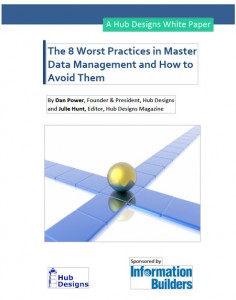Today’s business world changes at a breathtaking pace — even agile enterprises must work hard to keep up. And just as rapidly, companies are uncovering new competitive advantages through the increased use of “big data” and advanced analytics, often in real time.
By: Dan Power, Founder & President, Hub Designs & Julie Hunt, Editor, Hub Designs Magazine.
Keeping pace with on-‐demand decision making requires trustworthy data that must be accurate and timely. Enterprises can now use high quality data more effectively to optimize operations and business process execution, reduce costs, grow revenue, and increase competitiveness. By implementing solutions that transform data into true corporate assets, companies can now raise business performance and decision making to a new level of speed, power and incisiveness.
The strategic and tactical needs of the enterprise have put increased focus on the value and benefits of master data management (MDM). MDM consists of practices, processes and technologies for ensuring the accuracy, completeness, timeliness and consistency of multiple domains of enterprise data — across systems, functional areas and organizations. Master data embodies the mission critical, high value information shared and consumed by enterprise-‐wide business processes.
MDM is a key foundation for trusted data and more efficient business processes. It touches almost every important activity in a company. Using this data strategically can differentiate companies from their competitors. Overall, how well an enterprise manages master data is a reflection of how well it operates and achieves its objectives, and how quickly it can respond to change.
You gave us what we asked for, but it’s not what we want | The Business
Master data management is not just about data and processes. It depends on an alignment and partnership between business and IT, because both groups are critical to maximizing the value of MDM. The business has to guide the implementation and use of master data management in order to ensure alignment with overall corporate goals and objectives. IT has to build and operate the MDM architecture, and draws on its experience to guide the selection of technologies and partners.
But the road to a successful MDM program can be full of detours and dead ends. Frequently, MDM initiatives take wrong turns into “worst practices”.
One of the best ways to “get it right” when planning and designing a MDM and data governance program is to understand where things can go horribly wrong.
The 8 Worst Practices of MDM
- Executive sponsor missing in action
- Skipping the business case
- Setting up MDM as a “big bang” initiative
- Failing to plan for organizational and cultural change
- Taking a one-‐dimensional approach
- Underrating the importance of a data governance group
- No metrics for measuring success
- Relying on the wrong technologies
All articles are © 2015 by the authors.
The views and opinions expressed by our authors are those of our authors and do not necessarily reflect the official policy or position of IRM UK.
This article was featured in IRM UK’s Monthly E-newsletter. To subscribe please visit http://www.irmuk.co.uk/usefulinfo/enewsletter.cfm. Please note we are always on the look-out for new contributors so if you have an article you would like published please forward it to jeremy.hall@irmuk.co.uk for consideration.
IRM UK Strategic IT Training Ltd. 2nd Floor, Monument House, 215 Marsh Road, Pinner, Middlesex, HA5 5NE, Tel: +44 (0)20 8866 8366 E-Mail: customerservice@irmuk.co.uk Web: http://www.irmuk.co.uk



